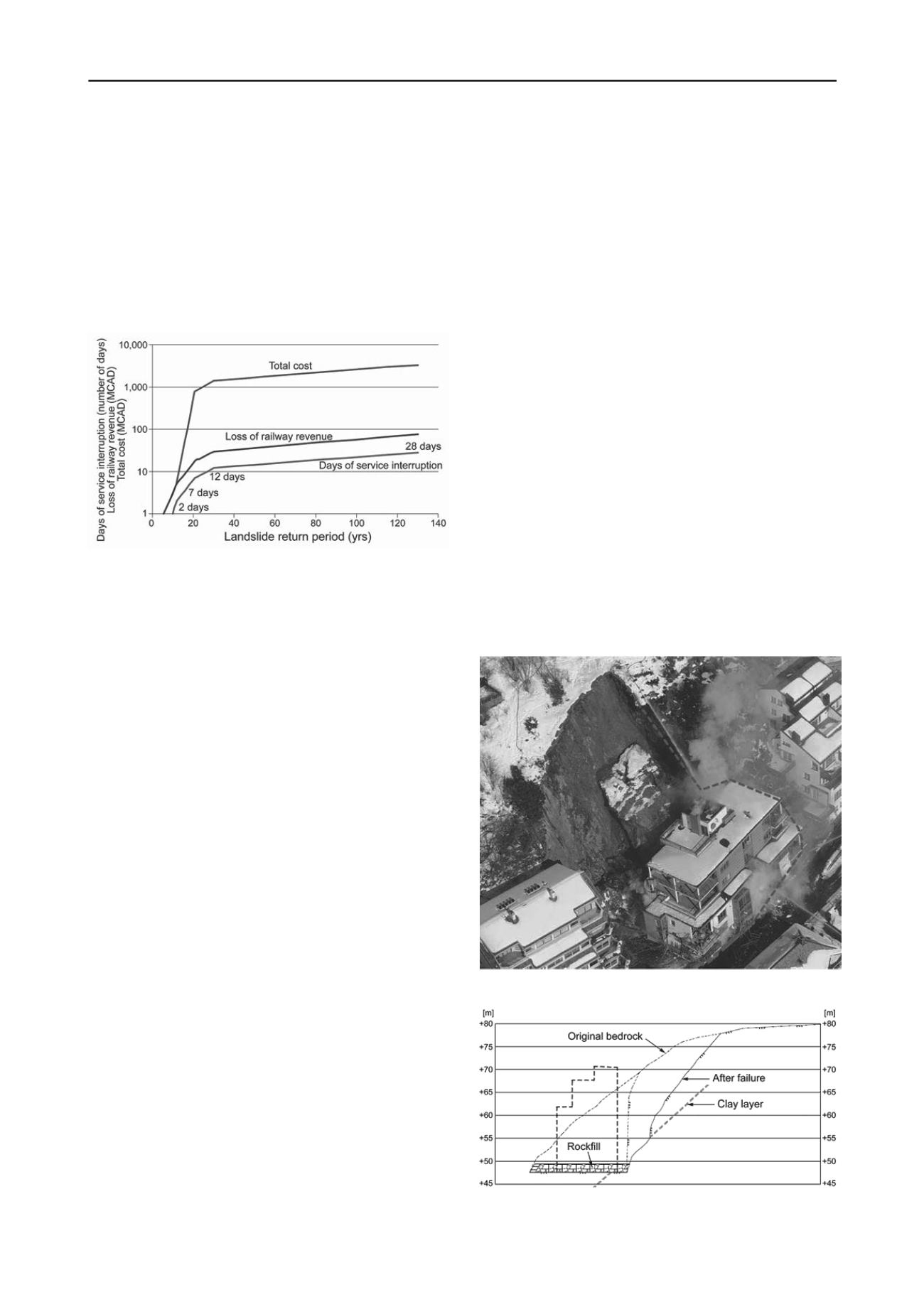
27
Terzaghi Oration
/ Allocution Terzaghi
Proceedings of the 18
th
International Conference on Soil Mechanics and Geotechnical Engineering, Paris 2013
The monitoring system had three GPS antennae on the land-
slide and one stationary reference antenna. Accuracy for the
longer term 24 hour averaged data was better than 5 mm. The
landslide monitoring data revealed that the landslide moved
fastest in the spring prior to the highest river levels (Bunce and
Chadwick 2012). The GPS landslide monitoring system could
provide real time warning to approaching trains of ground
movement and possible track misalignment.
Figure 28 illustrates on a semi-log scale the costs associated
with landslides in the Ashcroft Thompson River area as a func-
tion of the return period of the landslides.
Figure 28. Cost of landslides for the Ashcroft Thompson River railroad
(Bunce and Quinn 2012).
The total cost was calculated as the sum of the cost of rail-
way service interruption and the cost of the of railway revenue.
Figure 26 indicates that as soon as railway service interruption
exceeded about two to three days, the total cost became expo-
nential. The curves show that for a landslide with return period
of only 20 years, the total cost reach an astronomical sum of
800 MCAD or more. Preventing the smaller, more frequent
landslides became therefore a priority.
On the basis of the diagram in Figure 27, it would seem jus-
tified for the stakeholder to spend about 5 to 10 MCAD in miti-
gation measures to avoid the damage due to a 10-year return pe-
riod landslide. This was translated into a recommendation to
continue research with an additional 0.5 to $1.5 MCAD/year
and to do the stabilization of known landslides at a cost of 2 to 5
MCAD per landslide per year.
8.5
Lessons learned
This case study presents an excellent example of risk manage-
ment and decision-making under uncertainty, where the poten-
tial negative consequences on both short and longer term were
considered and a compromise solution was selected.
In one case, the decision was made to reduce the risk with
monitoring and warning to avoid the cost of mitigation with un-
certain outcome, and to avoid the environmental impact of sta-
bilizing the landslides. A GPS landslide monitoring system was
used to notify approaching trains if the ground movement has
exceeded a threshold that rendered the track impassable.
When the implications of avoiding or stabilizing landslides
are significant, this can be a viable risk reduction strategy.
However, this approach did not reduce the likelihood of a pro-
longed service interruption, with the ensuing costs.
With a view towards future improvements, the stakeholders
decided to invest in research and to quantify how much money
they could spend on mitigation compared to the cost on of let-
ting the landslides occur, in order to document the cost-
effectiveness of mitigation and monitoring.
9 THE AALESUND SLIDE
9.1
Description of the slide
During the night of 26
th
March 2008, a rock slope failed and de-
stroyed a new apartment complex in Aalesund, Norway. About
1400 m
3
of rock rammed in the building. The lower floors were
completely collapsed and set on fire. The entire building was
displaced by several meters. There were 20 persons in the build-
ing at the time of the collapse, and 5 persons, all from the lower
floors, died. The other residents were not injured. The accident
was tragic and affected many in Norway because of its actuality
and because it hit “close to home”, in the privacy of one’s
apartment. Figure 29 illustrates the sliding of the rock mass in
the building already on fire and attended by firemen.
The cause of the rock slide was the presence of a plane of
weakness filled with clayey material, and the creation of addi-
tional fissures by the blasting during the preparation of the site
before the construction started. Figure 30 illustrates the plane of
weakness.
9.2
Lessons learned
The accident could have been avoided if a proper site investiga-
tion had been carried out. In particular, geophysical methods
should have been used both before and after the blasting for the
site preparation. Before the blasting, the weakness plane would
have been discovered, and bolting would then have been under-
taken. The geotechnical/engineering geology site investigation
report was insufficient. This omission cost the lives of five per-
sons. After the accident, engineering geologists studied the sta-
bility of the rock for all neighbouring buildings, and the rock
wall has been stabilized.
Figure 29. The Aalesund rock slide
Figure 30. Sliding of rock mass on weakness plane (NGI files)


